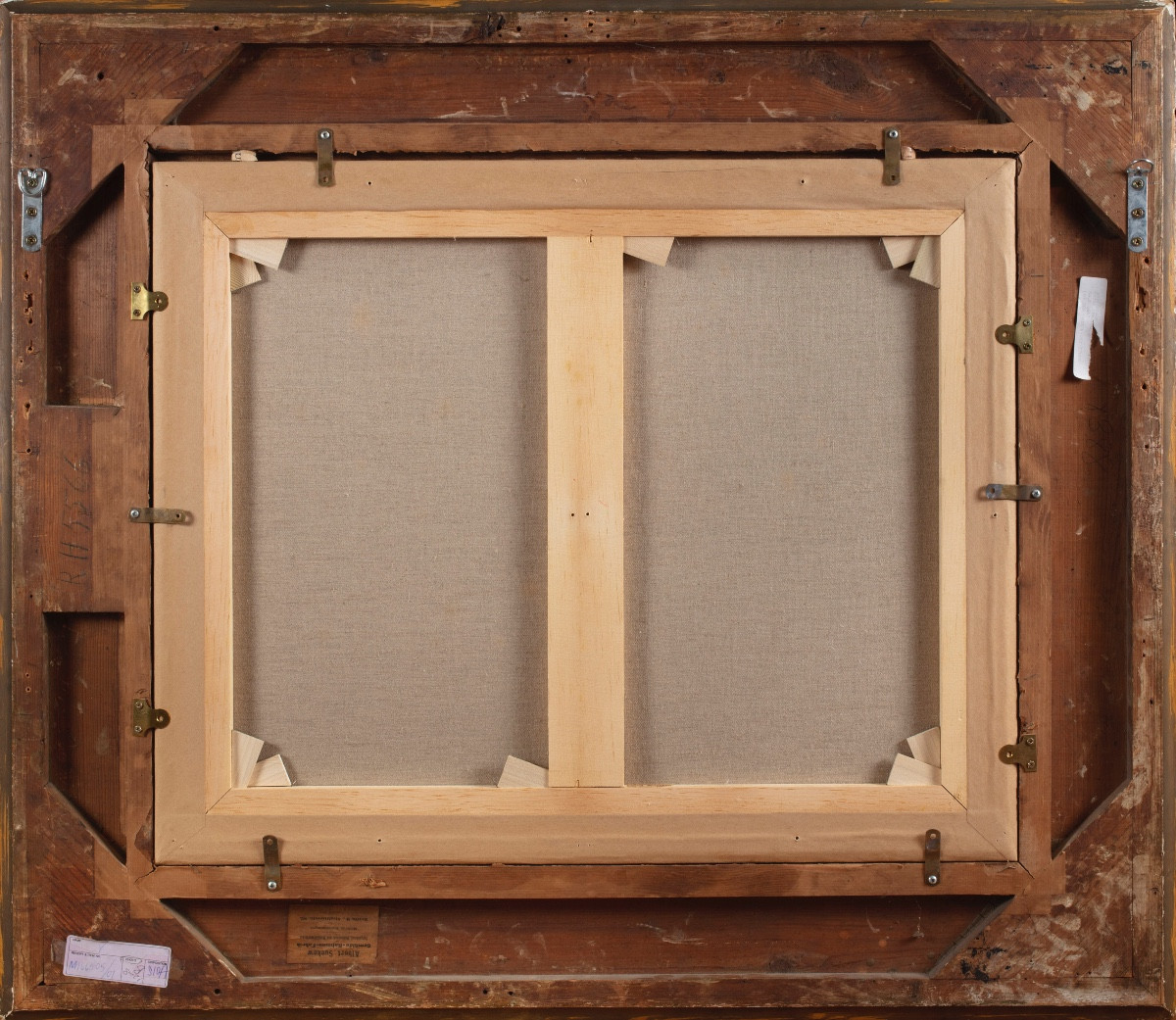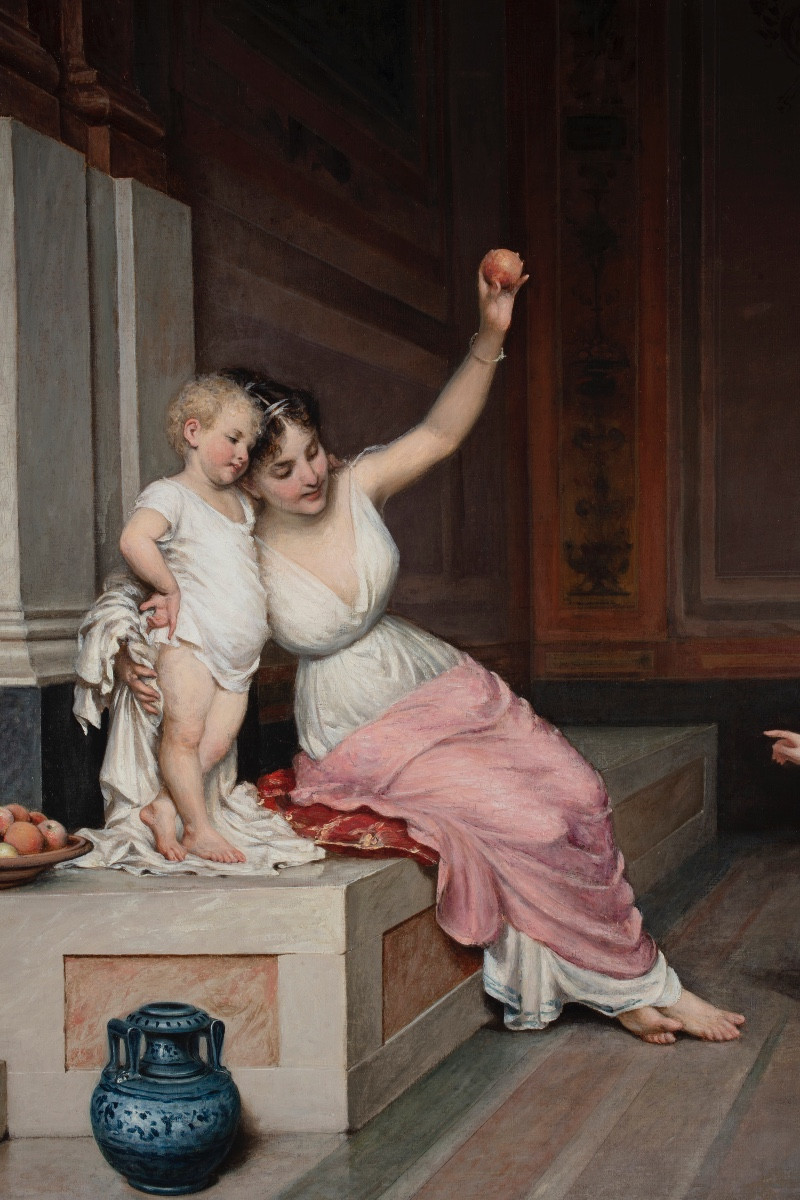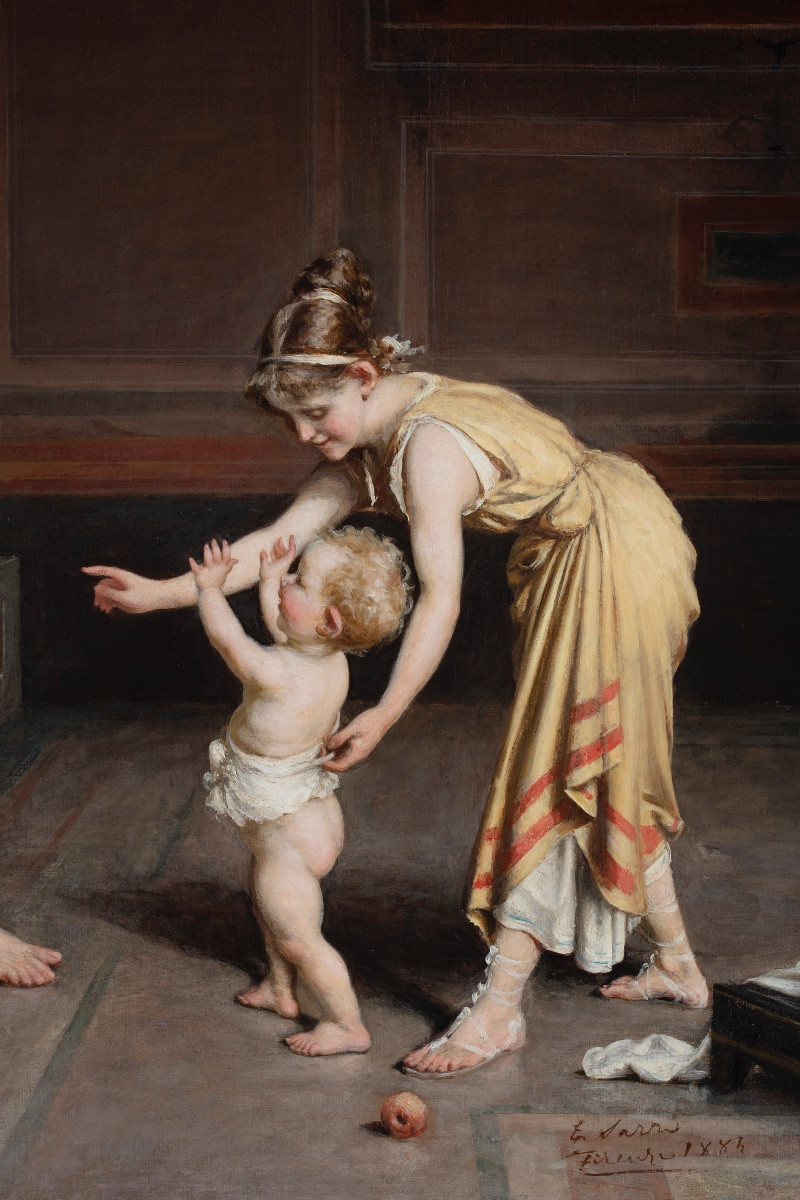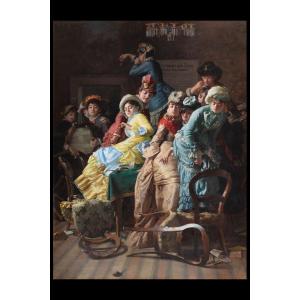Egisto Sarri (Figline Valdarno 1837 – Florence 1901), “First Steps”, 1884.
Oil on canvas, cm. 60 x 73
Signed "E. Sarri / Florence 1884" at the bottom right
The canvas depicts an interior scene from the cycle Daily Life in Pompeii. The subject that gives the work its title, “First Steps”, offers us an intimate and serene vision of what motherhood could have been like for a Roman matron, obviously reimagined by the artist. Inside the airy spaces of the domus depicted here, the walls frescoed with grotesques are tinged with dark muted colors, which contrast with the light gray of the marble floors. The room, rather bare, is decorated with a few objects: a small black and gold stool at the bottom right, near the signature; on the opposite side, a light blue amphora decorated with blue figures, with a decidedly anachronistic appearance; finally, a wooden basket full of fruit, among which we can identify apples and perhaps peaches.
It is precisely an apple that attracts the infant on the right, portrayed standing and slightly staggering, as he walks towards the female figure holding the fruit and whom we identify as his mother. Dressed in a white tunic and a pink ball, she is sitting on a bright red cushion, decorated with gold embroidery; this last detail, combined with the precious bracelet that adorns the woman's wrist, clarifies her social rank.
The infant waves his chubby little hands upwards with the intent of grasping the fruit, and in the meantime he takes timid and uncertain steps; the fingers of the very young maid, recognizable by her "slave" sandals, hold the little one up by a piece of cloth. Next to the mother and with an almost resolute expression, a slightly older boy watches the scene.
The two children with very blond curls frequently recur in other works by the artist, such as The Hour of Games and Woman with Two Children, both part of the same pictorial cycle.
BIOGRAPHY
Luigi Egisto Sarri was born in 1837 in Figline Valdarno, in the province of Florence. From a poor family, Sarri attended one of the schools dedicated to the less well-off of the pedagogue Lambruschini; in the meantime, he helped his father Raimondo, a house painter, in his work. At only eleven years old, he showed a strong aptitude for painting and drawing and, encouraged by his parents, he enrolled in the Academy of Fine Arts in Florence in 1850. Admitted to the School of Drawing and Figures thanks to a sheet of his depicting Guercino's Ecce Homo, he settled permanently in Florence to continue his studies, financially supported by the community of Figline and the Confraternity of the Misericordia. In 1854 he enrolled in the School of Painting of the Romantic artist Giuseppe Bezzuoli (1784-1855), and then, after his death, passed under the guidance of the Italian-Swiss painter Antonio Ciseri (1821-1891). Despite the awards and praise from his teachers, Sarri's economic situation continued to be precarious, forcing the young artist to work on poorly paid commissions. In 1857 he painted Lorenzo de' Medici escaping the conspirators' dagger in the sacristy of the Florence cathedral for an Academy competition, in which he unfortunately did not come in among the top places, as the master Ciresi regretfully noted in his diary. At the 1861 Solemn Exhibition of the Society for the Promotion of Fine Arts, Sarri exhibited a canvas painted a few years earlier, depicting Lorenzo de' Medici, later purchased by a local lord. During his youth, the artist reconciled Ciresi's teachings with the realist but less academic approach of the Neapolitan School, following in the footsteps of Domenico Morelli.
In 1863, King Victor Emmanuel II commissioned him to paint Corradino di Svevia che Ascolta la Sento a Death, on which he experimented extensively with light and color without obtaining the desired results, so much so that he left it unfinished. In the same year, he began his prolific activity as a portraitist, sometimes using photography, as in the Portrait of Gioacchino Rossini of 1866, in the portrait of Victor Emmanuel II of Savoy of about 1870, now in the Palatine Gallery of Palazzo Pitti, and Giuseppe Verdi, the latter made from photographs by the Alinari brothers. In 1865, he painted the frescoes on the piano nobile of the Crispi house in Florence; however, already two years later he increasingly withdrew into his studio, excluding himself from the more worldly Florentine artistic scene. In keeping with the French and English markets, Sarri began, in 1875, a fruitful series of paintings depicting Pompeian scenes with a domestic theme, which continued until at least 1887 and earned him a fair amount of financial success.
Towards the end of the 1870s, critics rediscovered an interest in historical paintings, as demonstrated by the Turin National Exhibition of 1880; for the occasion, he created the canvas Jacopo Guicciardini Rebuking Clement VII for the Siege of Florence, which however was not accepted at the Exhibition. Alessandro de’ Medici Kidnapping a Nun, now preserved in the Palazzo Pretorio of the municipality of Figline Valdarno, belongs to the same period. In addition to illustrious portraits, the painter was commissioned to create curtains and frescoes for some theatres in the province of Florence, as well as a series of religious canvases for monasteries and minor churches. In 1900 he took part in the competition promoted by Vittorio Alinari with the painting Apotheosis of the Madonna, now in a private collection, and in 1901 he finished his Self-portrait, now in the Uffizi. He died in November of the same year; his son Corrado (1866-1944) became a painter and above all an illustrator of children's books.





































 Le Magazine de PROANTIC
Le Magazine de PROANTIC TRÉSORS Magazine
TRÉSORS Magazine Rivista Artiquariato
Rivista Artiquariato